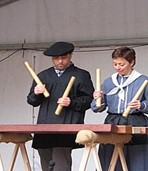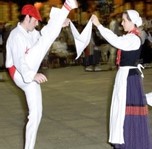Gala Dinner, Wednesday 6 Sept, Guggenheim Museum
Order of the evening
| 20:15 h | Opening of the doors (Main entrance) |
| 20:15 – 22:15 h |
|
| 21:30 – 21:50 h | Delegates visiting the galleries are called by the “Txalaparta (*)” to go down to the Atrium and begin to sit down with a cocktail served at each table. |
| 21:50 – 22:00 h | Welcome “Aurresku (**)” in front of the stage for the presidential table on behalf of all attendees |
| 22:00 – 24:00 h |
Social events:
|
| 24:00 h | End of the Gala Dinner – chaired by Jose L. Villate |
| (*) Txalaparta: | |
 |
During the last 150 years, txalaparta has been attested as a communication device used for many celebrations and special events. The txalaparta today is a musical instrument used in Basque music. It is classified as an idiophone (a percussion instrument).
In its traditional construction, being made of a pair of long wooden boards held up horizontally on two ends and then beaten vertically with special, thick sticks held upright in the hands. Music is made using the txalaparta by having one or more performers (known as ‘txalaparta players’) produce differing rhythms, playing with wood knots and spots of the boards for different tones. |
| (***) Aurresku | |
 |
Aurresku is a popular Basque dance, solemn and elegant, that is performed as a tribute or a way of honouring prominent figures of the society. As such, today it is performed in all types of formal events in the Basque Country: weddings, openings, congresses, etc. This is why it is one of the best-known expressions of traditional Basque culture.
In its modern form, the aurresku is performed by a dantzari (Basque word for ‘dancer’), accompanied by a txistulari, a musician who plays the txistu (traditional Basque wind instrument played with only one hand) and, with his free hand, the drum. |